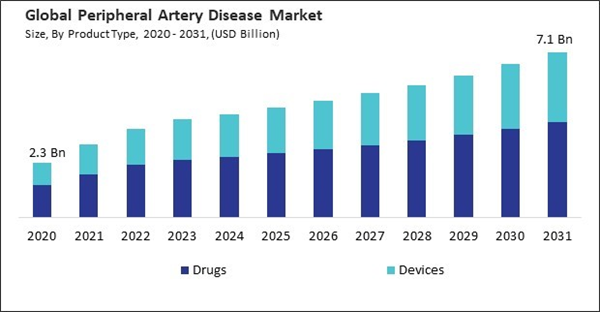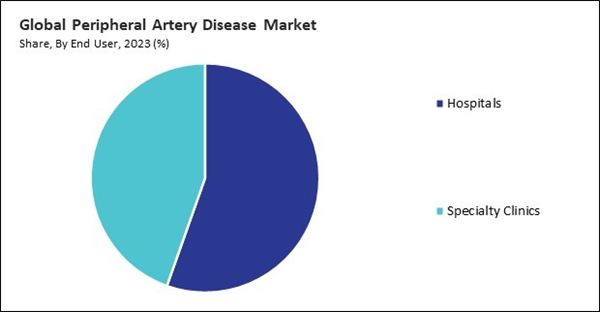Europe has a high prevalence of PAD risk factors, including an aging population, high rates of smoking, and increasing incidence of diabetes and hypertension. Europe's strong healthcare systems, particularly in countries like Germany, France, and the United Kingdom, contribute to the region's significant market share. Consequently, the European region would acquire nearly 30% of the total market share by 2031.
Parotid artery disease is a common cardiovascular disorder that frequently results in mobility challenges and discomfort. High blood pressure, or hypertension, is an additional significant risk factor for PAD. According to the World Health Organization (WHO), hypertension affects approximately 1.28 billion adults aged 30-79 years everywhere in the world. Hence, as the prevalence of PAD continues to rise, the demand for effective treatments and management strategies will drive market growth.
Additionally, the rapid advancements in medical technology are significantly transforming the landscape of PAD treatment, offering new hope and improved patient outcomes. Minimally invasive procedures are another area where technological advancements have profoundly impacted. Thus, such advancements are driving the growth of the market.
However, Drug-eluting stents, atherectomy devices, and minimally invasive procedures, while highly effective, come with substantial price tags that can be prohibitive for many patients. Furthermore, the high costs associated with advanced PAD treatments can stifle innovation and market growth. Hence, the high cost of advanced PAD treatments is a significant barrier to market growth.
Moreover, the economic downturn of the pandemic also posed significant challenges. Many individuals faced financial hardships due to job losses and reduced incomes, affecting their ability to afford medical care. High treatment costs, already a barrier for many PAD patients, became even more prohibitive during the pandemic. Healthcare providers also faced significant challenges during the pandemic. Thus, the pandemic had an overall negative impact on the market.
Driving and Restraining Factors
Drivers- Increasing prevalence of peripheral artery disease (PAD)
- Advancements in medical technology
- Rising proportion of the aging population
- High cost associated with advanced treatments and technologies
- Competition from alternative therapies
- Availability of favorable insurance and reimbursement policies
- Rising healthcare expenditure across the world
- Lack of awareness and early diagnosis
- Limited research and development
Product Type Outlook
Based on product type, the market is bifurcated into devices and drugs. The devices segment procured 41% revenue share in the market in 2023. In advanced cases where pharmaceutical treatments alone are insufficient, medical devices are essential for the diagnosis, intervention, and management of PAD. The devices segment includes various products such as diagnostic imaging tools, angioplasty balloons, stents, and atherectomy devices.End User Outlook
On the basis of end user, the market is classified into specialty clinics and hospitals. The specialty clinics segment witnessed 45% revenue share in the market in 2023. Specialty clinics are known for their patient-centered approach, providing personalized care plans and closer patient monitoring. Improved health outcomes are the result of this emphasis on individualized treatment, which also increases patient satisfaction and patient adherence to treatment protocols.Regional Outlook
Region-wise, the market is analyzed across North America, Europe, Asia Pacific, and LAMEA. The North America segment garnered 39% revenue share in the market in 2023. There are numerous factors that contribute to this dominance, including the high prevalence of PAD risk factors in the region, including diabetes, hypertension, obesity, and smoking.List of Key Companies Profiled
- Becton, Dickinson and Company
- Bayer AG
- Koninklijke Philips N.V.
- Abbott Laboratories
- Terumo Corporation
- B.Braun Melsungen AG
- Medtronic PLC
- Boston Scientific Corporation
- Cardinal Health, Inc.
- Biotronik SE & Co. KG
Market Report Segmentation
By Product Type- Drugs
- Antiplatelet Medicines
- Statins
- Anti Hypertensive Medication
- Others
- Devices
- Peripheral Stents
- Peripheral Angioplasty Balloons
- Peripheral Catheters
- Plaque Modification Devices
- Inferior Vena Cava Filters
- Hemodynamic Flow Alteration Devices
- Peripheral Accessories
- Hospitals
- Specialty Clinics
- North America
- US
- Canada
- Mexico
- Rest of North America
- Europe
- Germany
- UK
- France
- Russia
- Spain
- Italy
- Rest of Europe
- Asia Pacific
- China
- Japan
- India
- South Korea
- Singapore
- Malaysia
- Rest of Asia Pacific
- LAMEA
- Brazil
- Argentina
- UAE
- Saudi Arabia
- South Africa
- Nigeria
- Rest of LAMEA
Table of Contents
Companies Mentioned
- Becton, Dickinson and Company
- Bayer AG
- Koninklijke Philips N.V.
- Abbott Laboratories
- Terumo Corporation
- B. Braun Melsungen AG
- Medtronic PLC
- Boston Scientific Corporation
- Cardinal Health, Inc.
- Biotronik SE & Co. KG










